The Best Chapli Kabab
It’s here! A Chapli Kabab recipe that’s simple and easy to make yet tastes like it’s from an Afghan or Pakistani restaurant. This recipe includes tips on how to get them crisp and juicy without breaking. Tested to perfection!
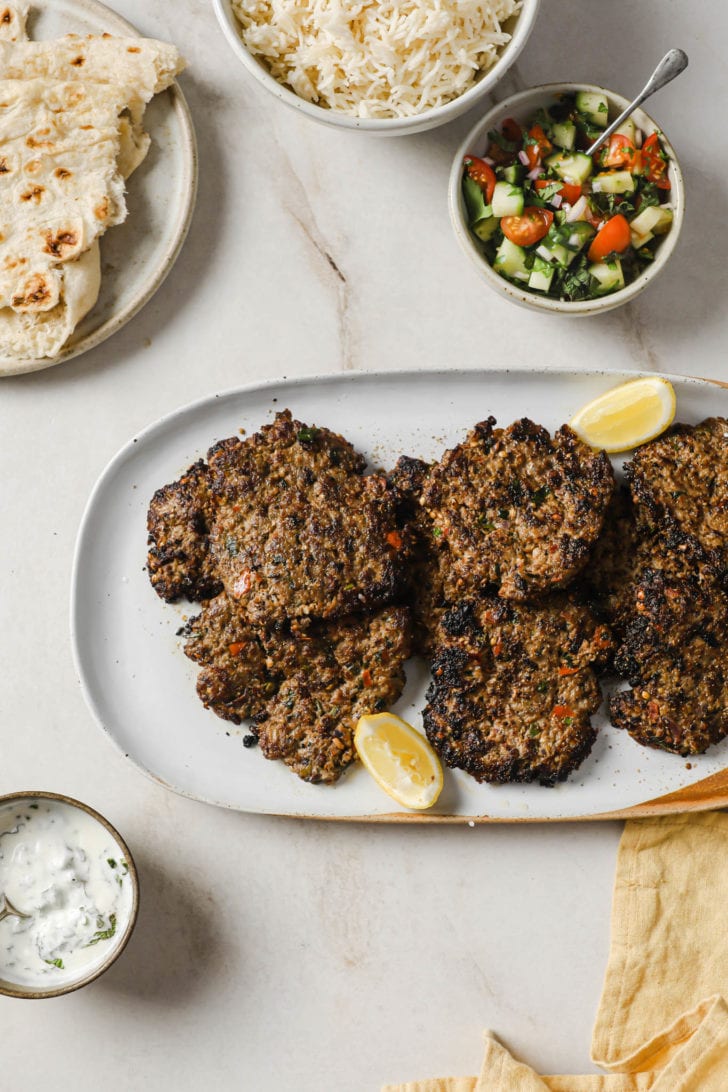
Want to save this post?
Enter your email below and get it sent straight to your inbox. Plus, get recipes & tips every week!
“I tried this today and it produced some of the best chapli kebab I’ve ever tasted. Your recipes are always so flavoursome and accurate, thank you again.”
Samira
I know, I know…just another food blogger claiming their recipe is “the best”. But, I’m not calling it the best in vain. The recipe below will be a hit, I can almost promise you that. I’ve had 3 beta testers confirm, with one saying it’s probably one of the best recipes on Tea for Turmeric. But while I’ve taken care of the formula for you, you’ll have to make them. And you can do it like a pro with these tips.
Navigation
The Top 3 Tips for Best Chapli Kabab
Here are my top tips to make next-level Chapli Kabab with the perfect texture:
- Overcooking (overfrying?) = crumbly, tough, dry kabab.
What makes restaurant Chapli kabab so soft and bendy (besides the excess amounts of fat😅)? A shorter frying time! So, once the exterior is nice and crusty and interior is just cooked, remove from heat. As soon as it’s overcooked, there goes the softness. - More hot oil = more browning. This is why street vendors straight deep fry them.
- Think flat & thin. Chapli Kabab aren’t thick, stubby hamburger patties. Try to get them thin (~1/3 inch), and if they start to shrink or puff up while cooking, flatten them with the back of a spoon or spatula. Don’t worry about making them perfectly round. Rough edges add character!
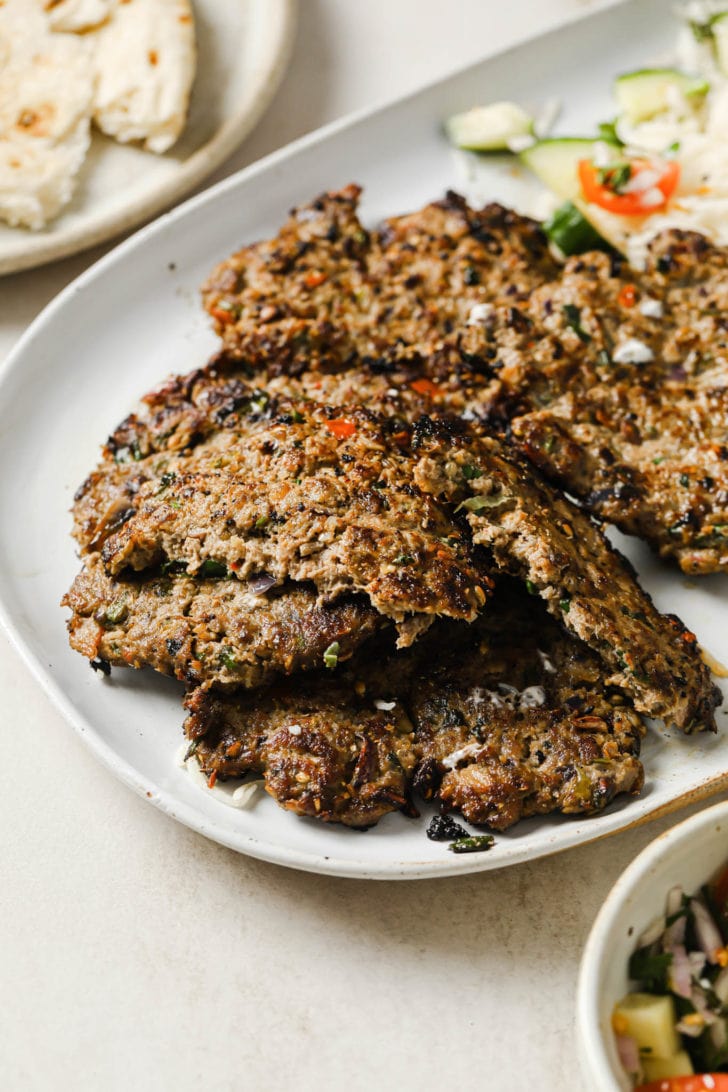
What are Chapli Kabab?
Chapli kabab are thin ground beef patties made with aromatics and spices. Unlike your usual grilled kebabs, Chapli Kabab are fried so they’re browned on the outside and tender on the inside. (If you want to avoid frying and prefer to bake, checkout my recipes for 25-Minute Fish TIkka and Chicken Kofta.)
Chapli Kabab have a unique flavor, with ingredients like dried pomegranate seeds (anardana) to lend them a slight tang and coarsely ground coriander to enhance their already crispy exterior.
Originally a delicacy around the Afghanistan and Pakistan frontier, they are now a popular street food and restaurant favorite.
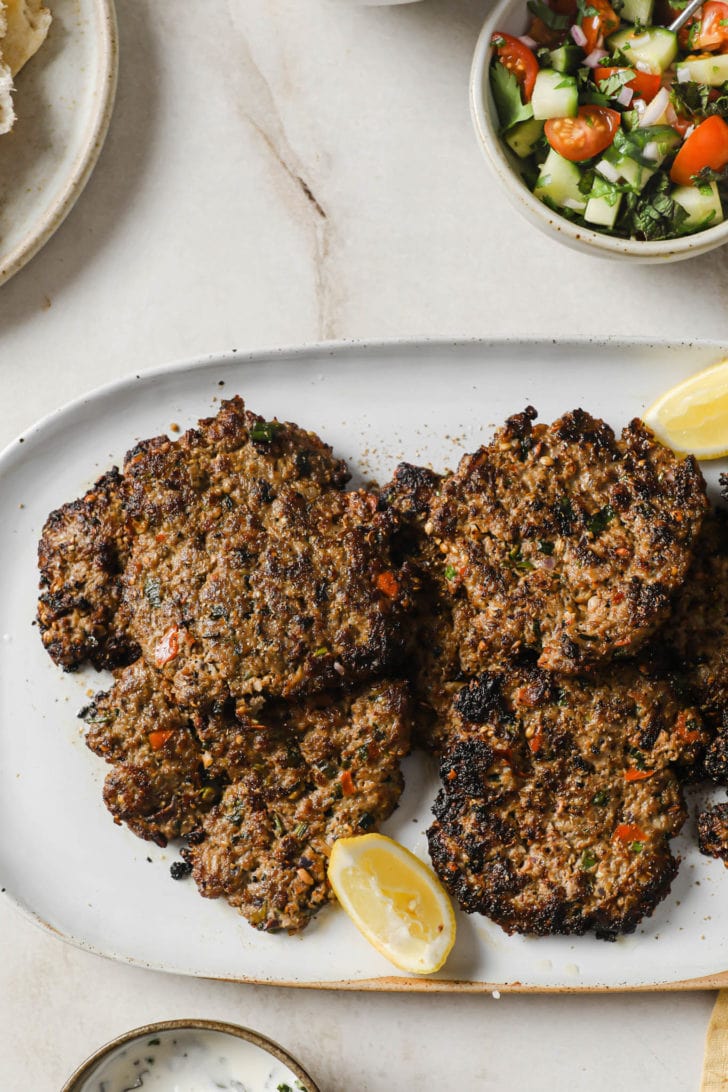
Origins of Chapli Kabab
Chapli Kabab originate from Peshawar, a city in Khyber Pakhtunkhwa (the same area that’s produced some of my favorites foods like Karahi).
While there’s no prevalent story about their origin, the ingredients reflect the culinary taste of the North Pakistan/East Afghanistan region – simple, not overtly spicy, yet so flavorful.
Why They’re Called ‘Chapli’ Kabab
Here are two theories:
- One theory (endorsed by the blog Afghan Cooks) is that Chapli is a derivation of the Pashto word “chaprikh”, meaning flat.
- The other theory is that it gets its name from its oval-shaped resemblance to a “chapal“, or slipper, in Urdu & Dari. (This explains why many people call them Chapal Kabab.)
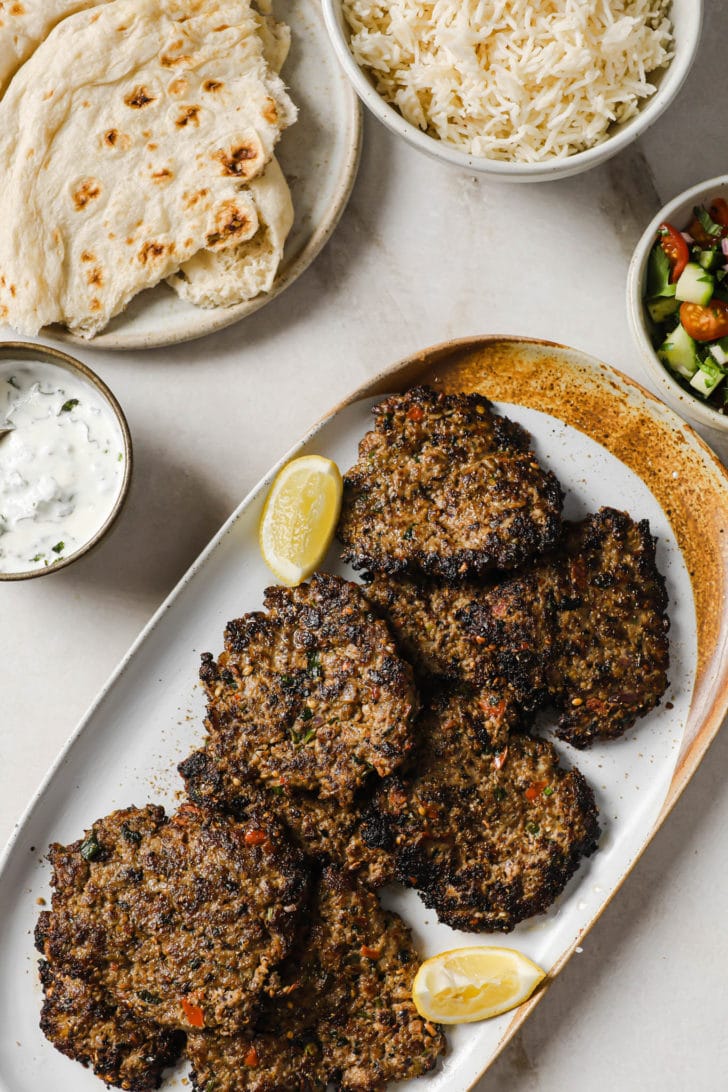
Ingredients in Chapli kabab
Only two of the required ingredients warrant a trip to the Desi Grocery Store:
- Dried Pomegranate seeds (Anardana): These are a key ingredient that help make Chapli Kabab..well..Chapli Kabab. They add a slight tang and crunch. I love adding the full 2 tablespoons (more than most recipes!) but you can decrease to one tablespoon to make them more subtle.
- If you positively don’t like the crunch, a great substitute is 2-3 teaspoons of pomegranate powder or even pomegranate molasses.
- Corn Flour (Makki ka atta) or Gram flour (Besan): Helps bind the kababs while enhancing the taste. Though some authentic recipes insist corn flour (which is like cornmeal but finer) is the only way to go, I know gram flour/besan (different from chickpea flour) is much more likely to already be in your pantry. Plus, I tested it & they both work perfectly well.
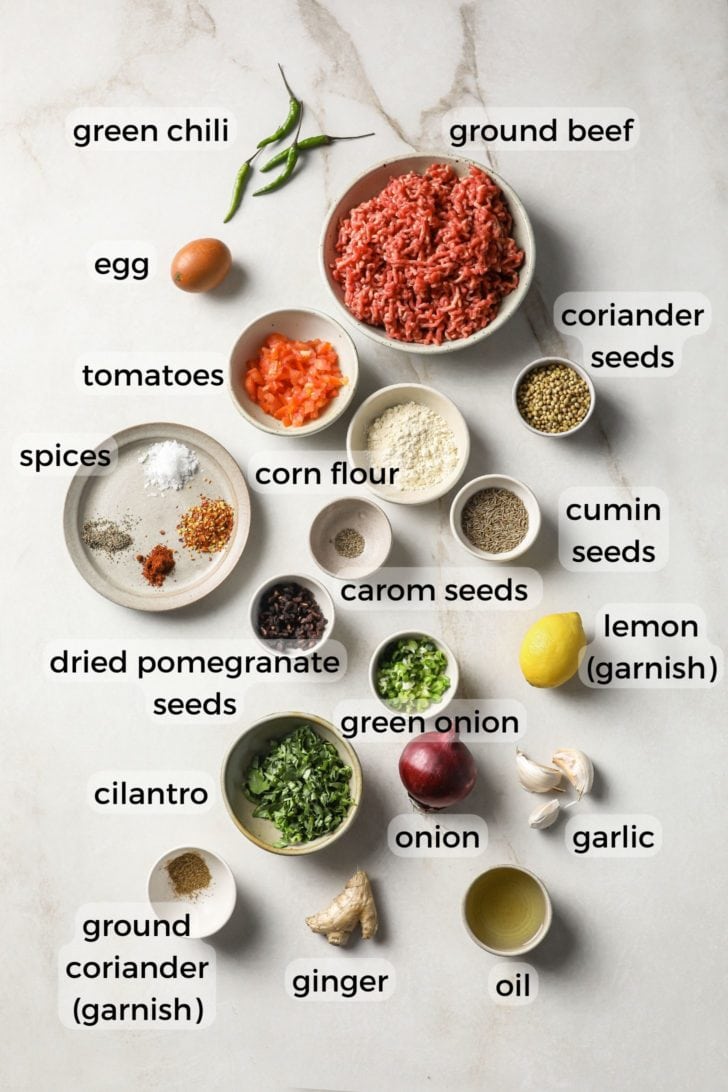
The rest of the ingredients are more commonly available. Here are notes on most of them:
- Ground Beef: Restaurants and street vendors use much more fat than we’re accustomed to. I suggest using regular ground beef (20% fat), but you can get away with as low as 12% fat.
- Whole Spices:
- Coriander seeds – Add texture and subtle flavor. 3 tablespoons may seem like an aggressive amount, but trust me – my favorite Afghan restaurants do this. I’ve just followed suit.
- Cumin seeds – Another essential.
- Carom Seeds – Optional – Use if you already have them!
- Red chili flakes: These add textured spice rather than making the kababs very spicy. Add more if you’d like more spicy!
- Green chili peppers: Used for color and heat. I use Thai/birds eye or Serrano, but you can use jalapeño or any other type of green chili.
- Red onion: Adds moisture, texture, and taste. You can sub yellow or other onion, but I like the taste and how they don’t release too much excess moisture. If your onions happen to be too watery, squeeze out the moisture before adding to the kababs.
- Spring onions (scallions): One of my favorite Afghan restaurants in Houston, Saffron Kabab House, uses only spring onions. I adore the complex flavor they add along with the red onion.
- Tomato: For texture, freshness, and subtle tart-sweet flavor. Because they release moisture, it’s important to finely dice them instead of blitzing in a food processor. Some kabab houses take a slice of tomato and slap it on one side of the kabab while frying. Tried it. Prefer tomatoes intermingling.
- Raw egg: Binds and moistens kababs. In some recipes, you’ll also find coarsely crushed pieces of soft-boiled or scrambled eggs in the kababs, which is meant to make them more tender. I tried adding & didn’t find them worth the effort.
- Oil: Many recipes use ghee (or even tallow fat) to fry them. I find it gets heavy & overpowering with ghee, so I stick to oil.
- Garlic + Ginger: Very finely chop/mince these using a food processor. You can also crush using a mortar & pestle.
How to Make Chapli Kabab
- Toast & grind the spices. Toasting deepens the flavor while removing the raw taste of the spices. Add them to a spice grinder (or even a food processor) along with the pomegranate seeds. Roughly crush.


- Toast the corn flour or gram flour. Again, enhances the nutty flavor of the corn flour. You can probably get away with not toasting, but I toast. It takes 5 minutes. You can do it. Or not. Follow your heart on this one.
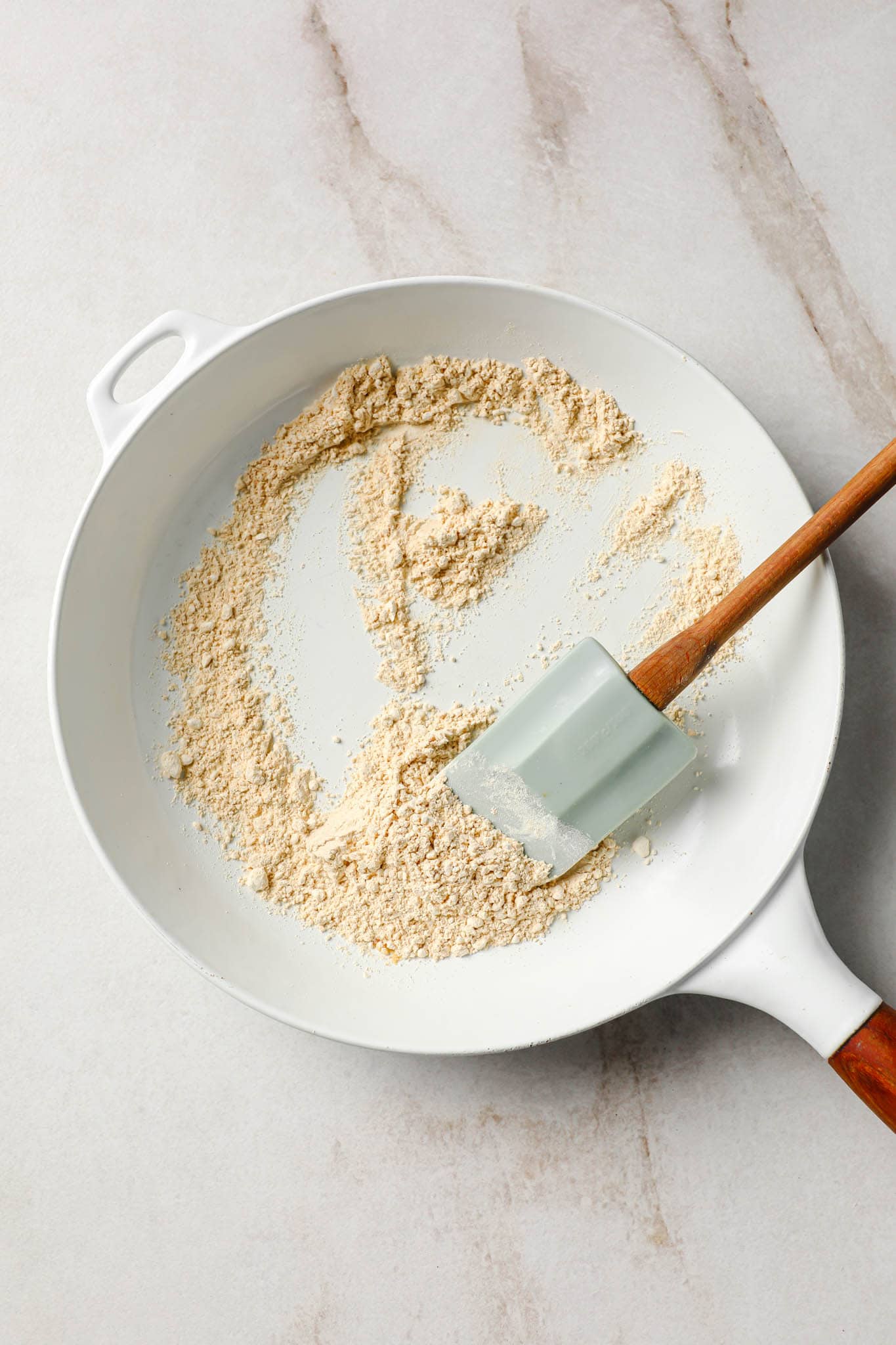
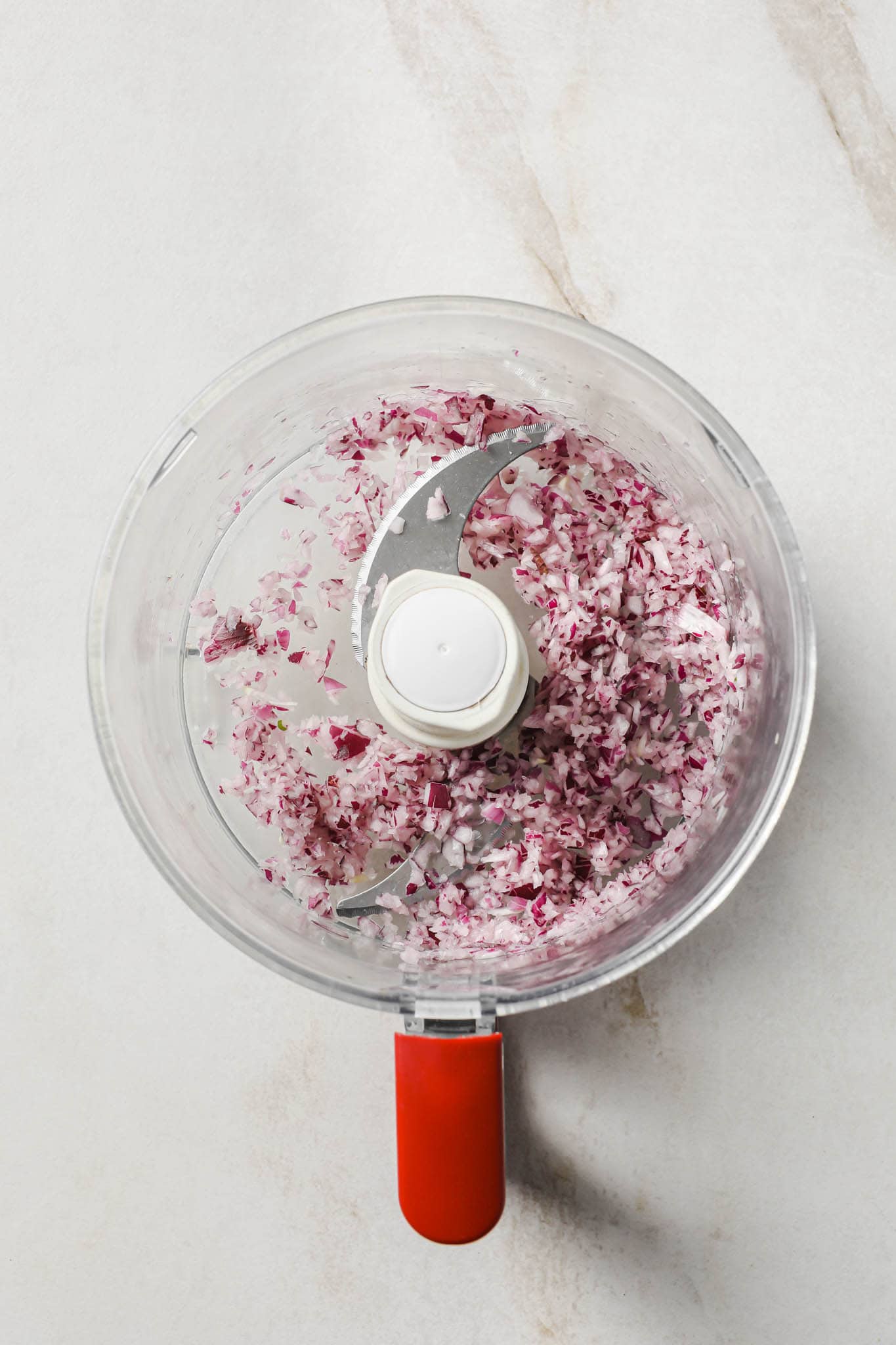
- Combine all the ingredients in a bowl, including the prepped ones above.
- Mix/knead the dough vigorously until you can see the stringy texture of the meat. You can also use the paddle attachment of a stand mixer to do this.
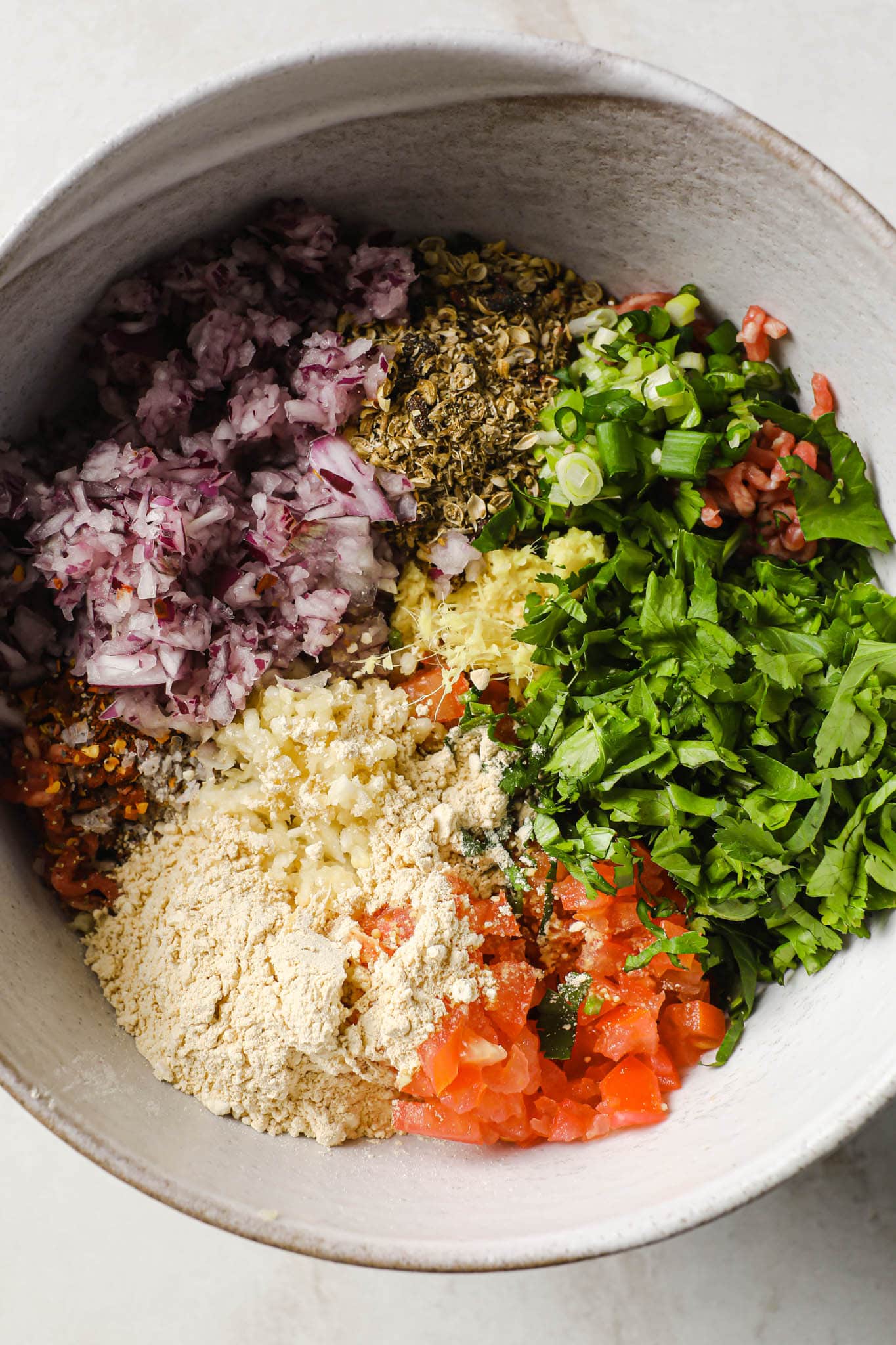
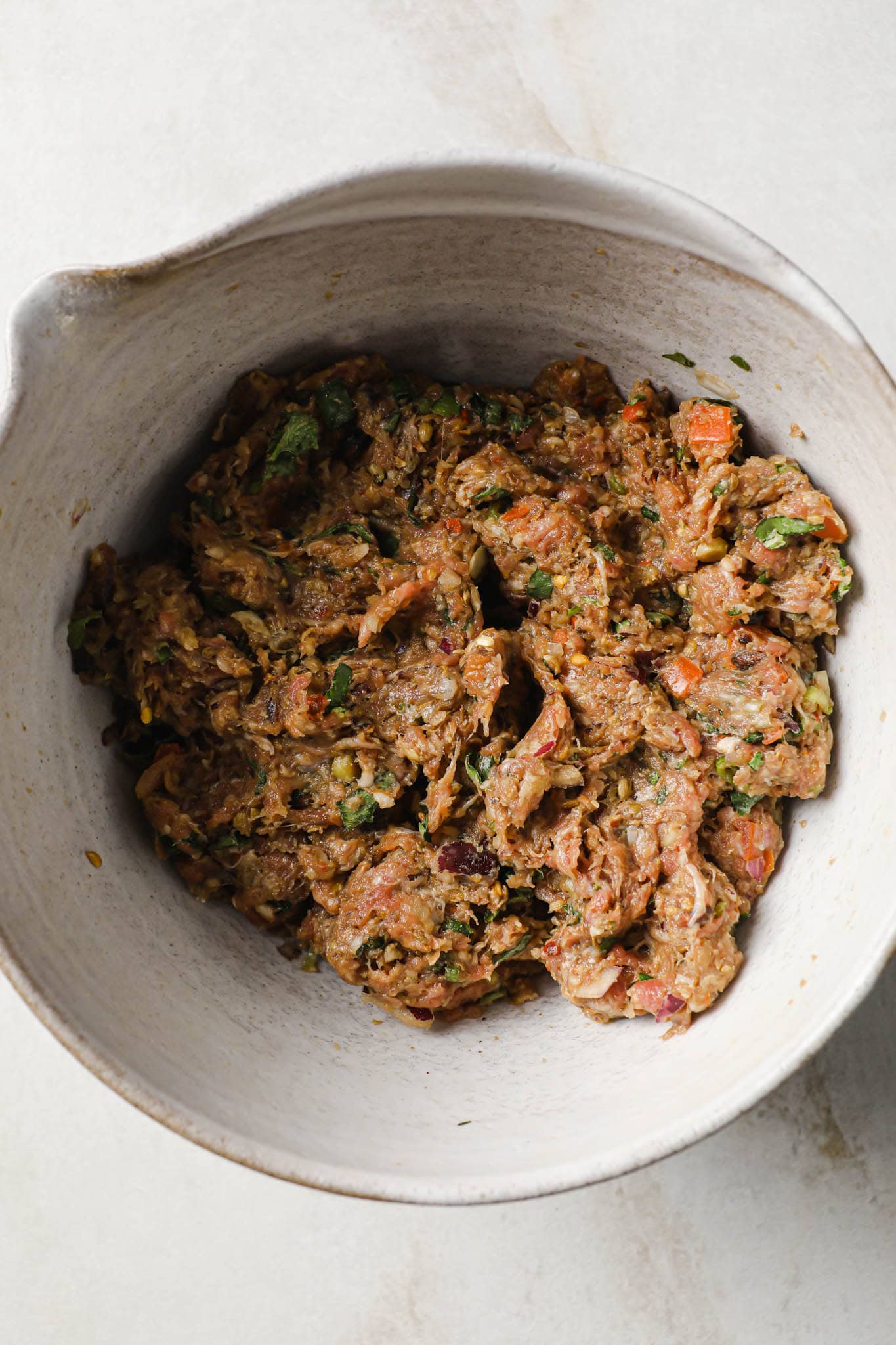
- Fry! There are 2 ways to do this. The first one is obvious. Shape into patties. But, if you can, smash them directly on the pan.
Option 2 for Frying – Smash Burger Method: There’s a reason the street vendors place a ball of the mixture onto the large pan and then slap it flat. It’s the same technique used by hamburger restaurants – the smash burger method.
If you form them into patties before frying, it doesn’t give the same amount of crust that you get from smashing the burgers directly on the pan. (That said, I certainly don’t have the dexterity of Kenji nor Chapli Kabab street vendors and therefore think it’s perfectly acceptable to shape them beforehand.)
Quick Tip: If using the smash burger method, the bottom of the spatula can stick to the burger. To prevent that, dip the spatula in oil so it doesn’t stick to the patty while you press down on it.
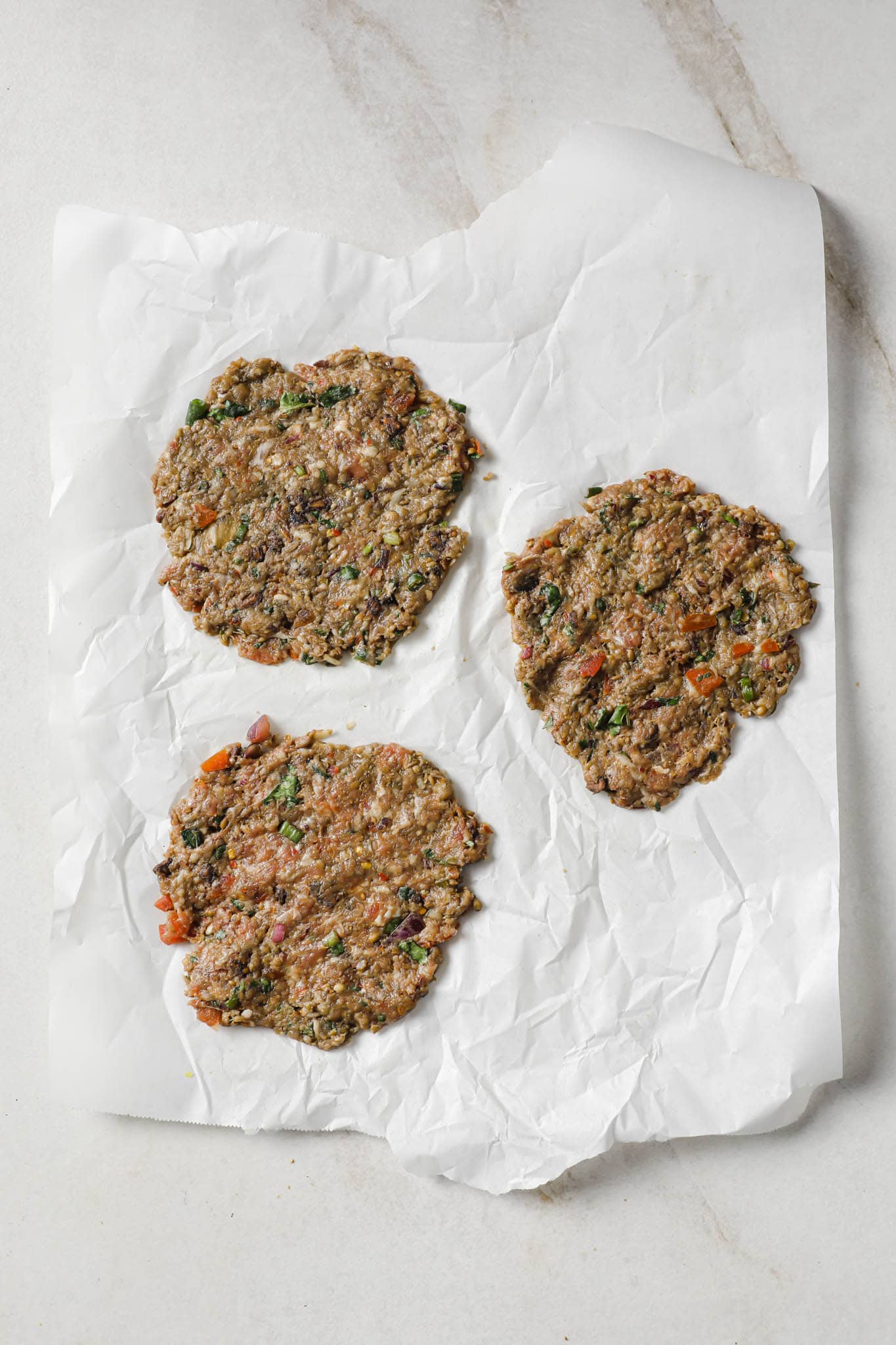
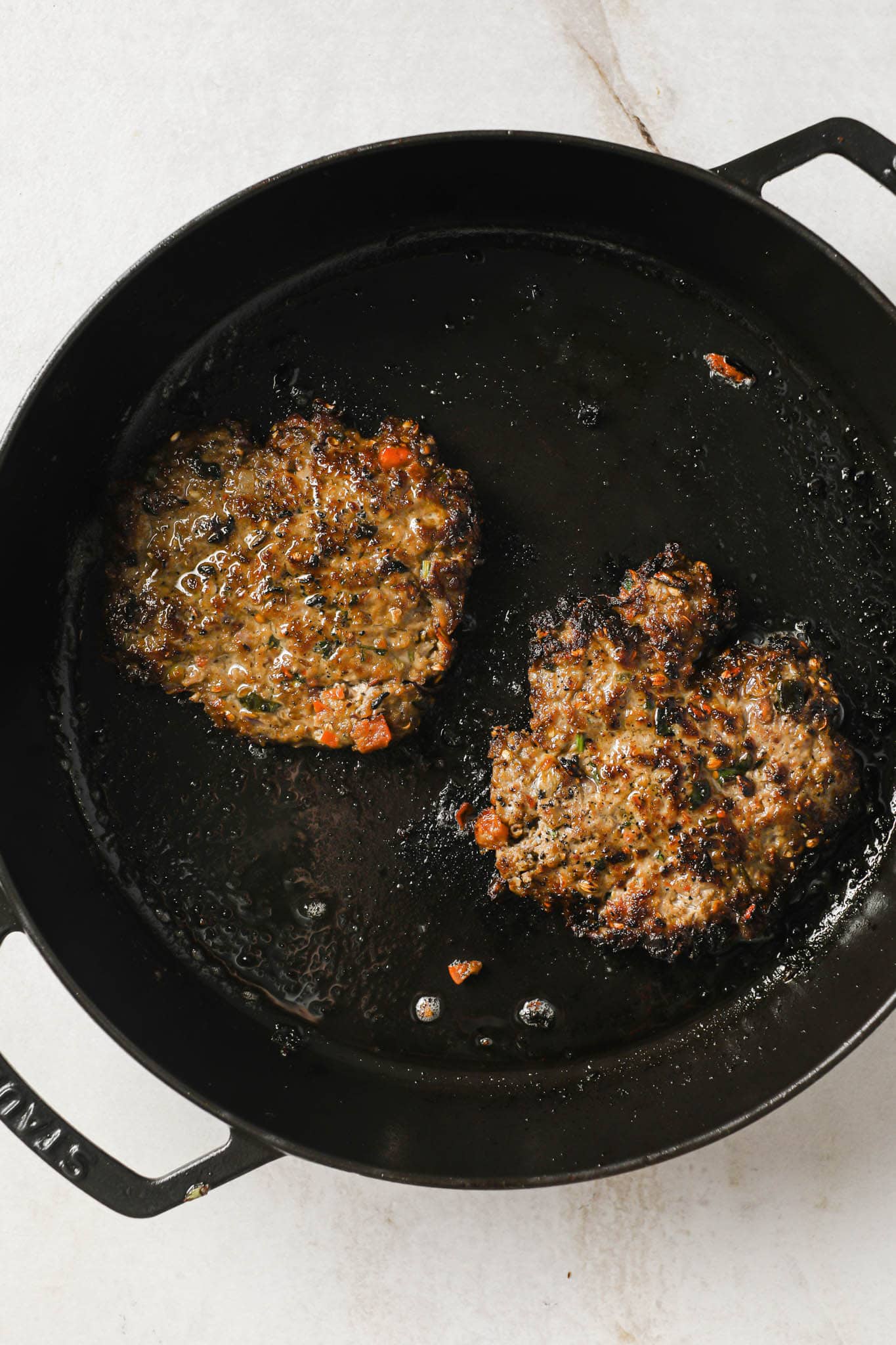
- Serve immediately with a sprinkle of ground coriander and cilantro.
How to Make Chapli Kabab Soft and Tender
- Don’t skimp on fat. 20% is ideal, but you can get away with 12% and still have them hold shape.
- Like I mentioned earlier, try not to cook for too long as that can dry out the beef. As soon as the exterior is crusty, remove from heat.
- Egg adds softness, so if the mixture seems dry, try adding a bit more.
How To Prevent Chapli Kabab from Breaking
Here are 3 key tips to prevent Chapli Kabab from falling apart:
- Knead the mixture so it’s homogenous instead of crumbly. Same technique as Seekh Kabab – kneading the meat helps bind the meat proteins (similar to how gluten binds flour!).
- Squeeze out any moisture from the tomatoes and onions and drain out any moisture from the ground beef (pat dry with a paper towel if needed). If you think moisture is what’s breaking them, add an extra tablespoon of corn flour or besan.
- Flip carefully. Slide your spatula all the way underneath the kababs and use another small spatula to hold the kababs in place. (See video for visual instruction.) If needed, make them smaller so they’re easier to turn.
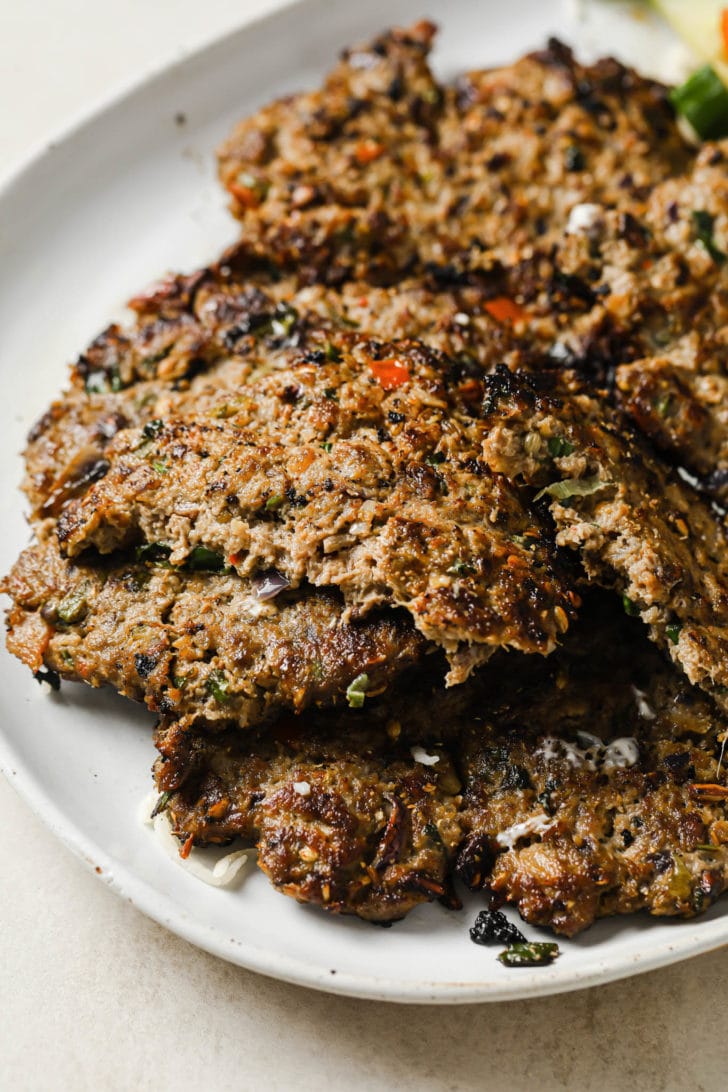
How to Store & Reheat Chapli Kabab
You can store the mixture or formed kababs in the fridge, airtight, up to a day. You can also refrigerate for 1-2 days after frying them. When ready to serve, either reheat in the microwave, lightly fry, or air-fry the kababs to help get the crisp back.
How to Freeze
Like Seekh & Shami Kababs, Chapli Kabab are freezer-friendly.
- Omit tomatoes: You want as little water as possible in the kababs to prevent them from getting icy. Omitting tomatoes is a surefire way to prevent the possibility of breaking after thawing.
- To freeze, shape the patties, then store them between layers of parchment paper so the kababs don’t stick together. Store in an airtight container in the freezer.
How to Thaw
When ready to fry:
- Either thaw in the fridge for 6-7 hours or allow to sit at room temperature for an hour or two. For a quick defrost, I’ve tried using the defrost setting in the microwave to partly defrost and that worked fine. Try not to microwave on High/normal setting as they can lose too much moisture. Fry as you normally would.

How to Serve Chapli Kabab
Traditionally, they’re served with naan or roti with mint raita on the side. Many Afghan restaurants here in Houston serve it with rice or a simple pulao or challow. Chapli Kababs are also great served alongside Kachumber Salad or crunchy vegetables for some added crunch. If you are looking to add an appetizer to your meal, Pakistani Chicken Patties would be great!
They also make great Chapli Kabab burgers. Try serving them alongside the usual toppings and sriracha mayo or other burger sauce. So good!
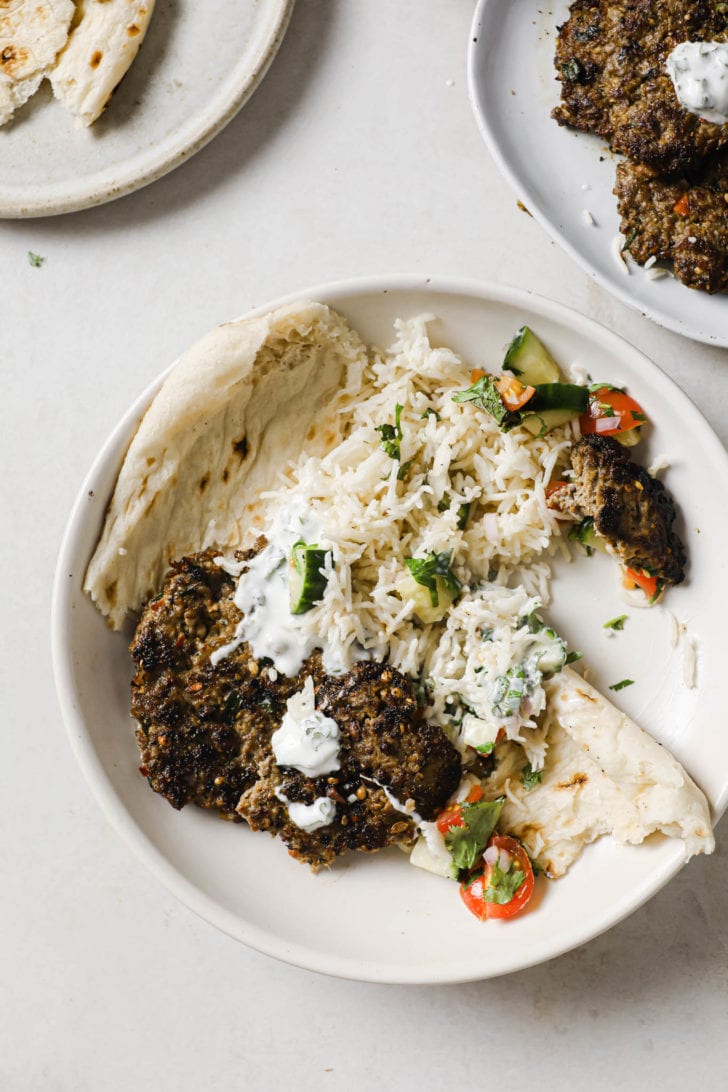
FAQs
Yes! To keep them moist, try using chicken thighs instead of chicken breast.
I wouldn’t bake but you could try broiling. I haven’t tried air-frying, but I think it’d work well (better than baking). Rough recipe – place the kabab in a single layer leaving room on both sides. Cook at 400°F for around 3 min, until browned. Then turn and air-fry until cooked through (roughly 2 min).
If making them on the grill, try omitting tomatoes or using more gram/corn flour to hold them up. You can also use a grill liner or aluminum foil with holes which allows for easier cooking and flipping.
Double all the ingredients. Click the 2x or 3x button on the recipe card and it’ll adjust the quantities for you. Replace frying oil as needed if it starts to darken.
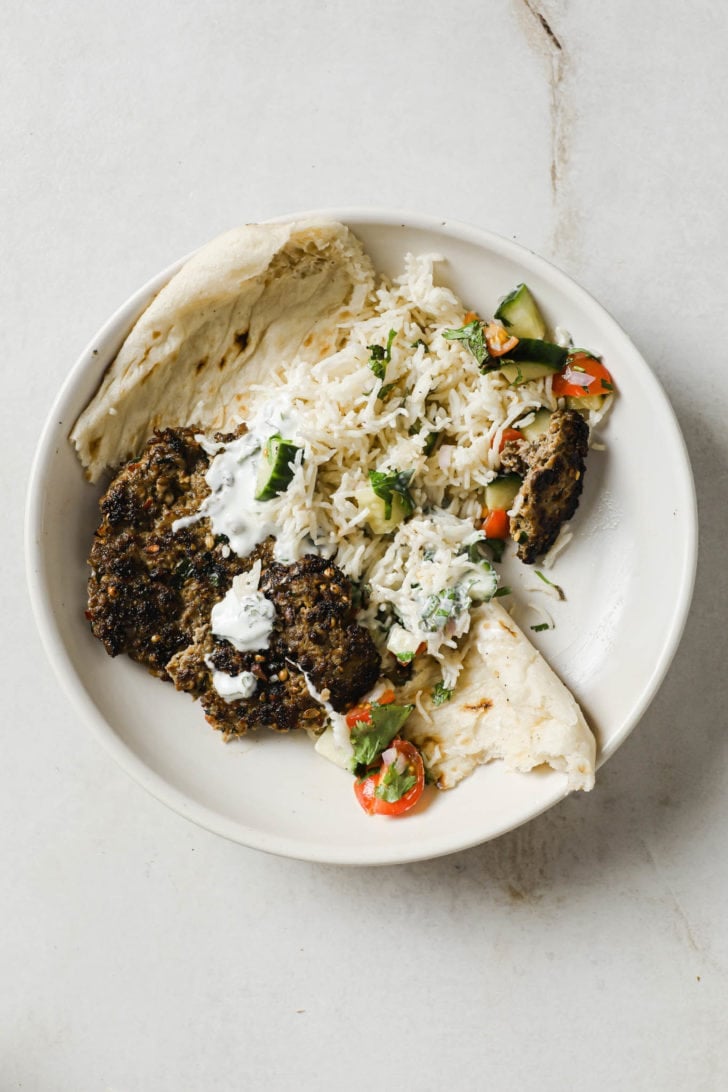
More Beef Recipes You’ll Love
- Pakistani Seekh Kebabs
- Easy Nihari (Pakistani Beef Stew) – Stovetop + Slow Cooker
- Pakistani Aloo Keema (Ground Beef and Potato Curry)
- Easy Pakistani Haleem (Instant Pot)
- Easy Instant Pot Pakistani Beef Curry (Stew)

Tried this recipe? If you have a minute, please consider leaving a comment telling me how it was! If you have a photo of your dish, please feel free to upload it and share with others. If you’re on Instagram, please tag me so I can see your creations. I truly love hearing from you. Thank you!
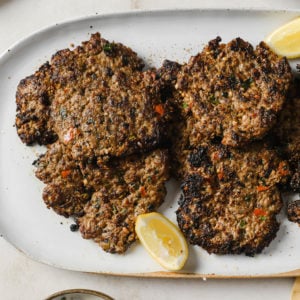
The Best Chapli Kabab
Watch the Video
Ingredients
- 3 tbsp coriander seeds
- 1 tbsp cumin seeds
- ¼ tsp carom seeds – ajwain, optional – use if you have it
- 1.5-2 tbsp dried pomegranate seeds, anardana – See Note 1
- 3 tbsp (25 g) corn flour (makai ka atta) or gram flour (besan)
- 1 lb (454 g) ground beef, 20% fat – not lean
- 1/2 medium to large (150 g) red onion, very finely chopped – may use pulse function of food processor for this
- 2 (30 g) green onions (scallions), both white & green parts, finely chopped
- 2-4 small (5 g) green chili peppers (such as Thai/Bird's Eye Chili or Serrano), finely chopped
- 3-4 garlic cloves, finely chopped or crushed
- ½-3/4 inch ginger, finely chopped or crushed
- ¼ cup (8-10 g) cilantro leaves (fresh coriander), finely chopped
- 1 tsp red chili flakes, plus more to taste
- 1/4 tsp red chili powder
- 1/4 tsp ground black pepper
- 1 ½ tsp kosher salt, or to taste
- 1 egg, whisked
- 1 small (70-100 g) Roma tomato, deseeded and very finely diced – discard excess pulp/juices – See Note 2
- neutral oil, for frying
Garnish
- ground coriander
- cilantro leaves
- lemon wedges, to serve alongside
- Cilantro/Mint Raita (Yogurt Chutney), optional – to serve alongside
Equipment
- Skillet (preferably cast iron but any will do)
- Large Spatula (for turning the kababs)
- Spice Grinder or Food Processor (for roughly crushing spices)
Instructions
- Heat a small to medium skillet over medium-low heat. Add the coriander seeds, cumin seeds, and carom seeds (if using). Toast, stirring and shaking the skillet often, for 3-4 minutes. The seeds will deepen in color and become highly aromatic. Remove from heat and transfer to a spice grinder, food processor, or mortar and pestle. Add pomegranate seeds to the spice grinder. Pulse to roughly grind 4-5 times (you don’t want a fine powder, just roughly crushed up seeds).
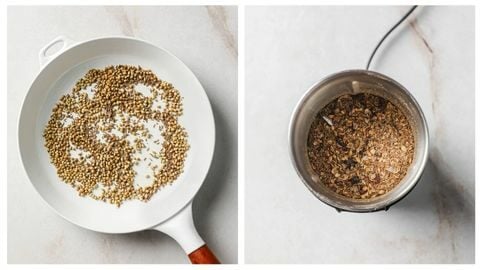
- In the same skillet over medium heat, add the corn flour or chickpea flour. Toast until it deepens in color and smells toasty (~4-5 minutes). Turn off the heat and allow to cool.
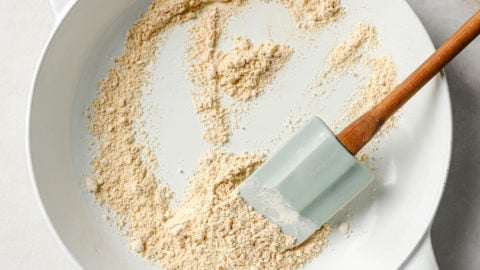
- In a medium bowl, add the ground beef along with the remaining ingredients (ground coriander mixture, toasted corn flour, red onion, green onion, green chili pepper, cilantro, garlic, ginger, red chili flakes, red chili powder, black pepper, salt, egg, and tomatoes (if using)).
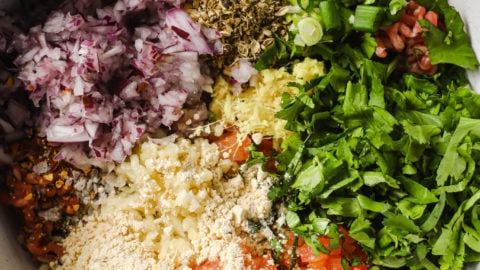
- Using gloved hands (try not to use bare hands or the green chili may sting), knead for 3-4 minutes, until you begin to see a lacy, stringy texture (resha) of the meat. (Alternatively, you can use the paddle attachment of a food processor and knead on medium speed for 2-3 minutes.) The mixture should be homogenous instead of crumbly. Cover and set aside or refrigerate up to 24 hours.
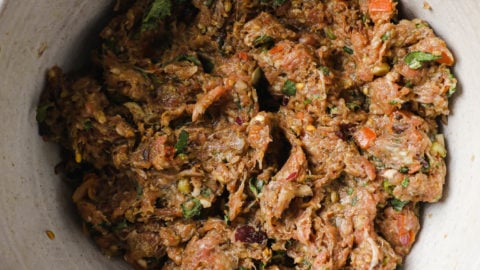
- Heat a cast iron skillet over high heat. Add enough oil to generously cover the bottom of the skillet.
- To test a piece for taste, place a piece of the beef mixture on the pan to cook, turning over as needed. Taste and adjust salt and seasoning if desired.
- Using oiled hands, take around 1/4 cup heaped (~90g) of the meat and form into a hearty round shape.
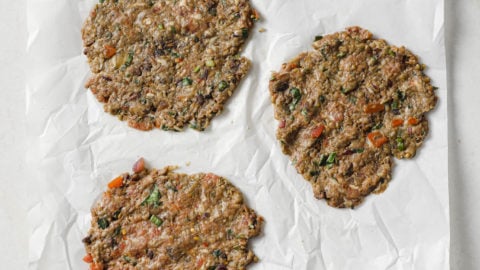
Option 1 –
- Place the round ball on the hot cast iron and use the flat part of a sturdy spatula to press it down until it is 4.5 inches in diameter and no more than 1/3-inch/¾-cm thick.
Option 2 –
- Use your hands to shape the patties until they’re 4.5 inches in diameter and no more than 1/3-inch/¾-cm thick. Place on hot pan.
- Use a spoon or small spatula to flatten and spread (uneven sides add character!). Fry for 1 ½ to 2 minutes on each side, using your spatula or a spoon to push oil on top of the kabab. Do not overcook. You want it crispy and charred on the outside and just cooked on the inside. (Internal temp 160°F/71°C)
- Flip over by lifting the kabab using a large spatula and small spatula to hold it in place (see video!). Transfer to a paper towel-lined plate. If the mixture is not binding well enough, add 1 tbsp of corn flour or gram flour. Fry remaining kababs, replacing the oil if it starts to darken.
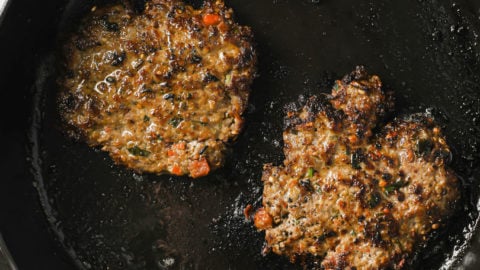
- Garnish with a sprinkle of ground coriander and cilantro. Serve immediately with mint raita and lemon on the side.
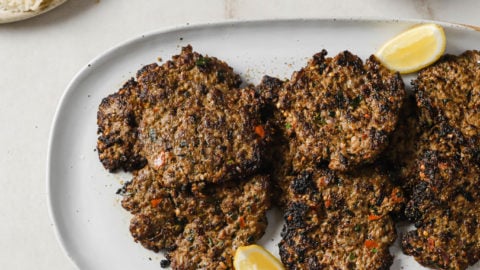
Notes
- If you positively don’t like the crunch, a great substitute is 2-3 teaspoons of pomegranate powder or even pomegranate molasses.


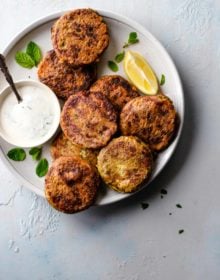
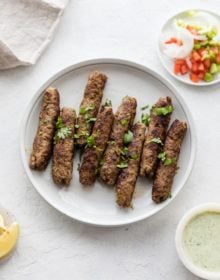
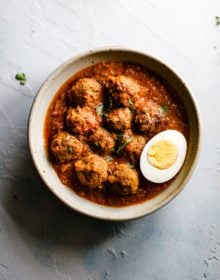

46 Comments on “The Best Chapli Kabab”
Each page of your website is a goldmine waiting to be unearthed.
So nice of you to say that. Thank you, Dia!
If we wish to use pommegranate molasses as a substitute, at which stage should it be added and would 2-3 tsp be the right amount?
Thank you.
Hi Nadia, Thank you for your questions. Pomegranate Molasses isn’t traditionally use in Pakistani cuisine. It has a sweet/tart flavour profile so I’m not sure how it would work with Chapli Kabab since they are not meant to be sweet.
Thanks Asiya, that’ makes sense, the main reason I asked is that molasses are mentioned under Note 1 and I happen to have that.
(I used molasses and they turned out great still)
Excited to make these! If I only have table salt, how much should I use?
I would start with a 1 1/8 tsp to be on the safe side, but I think they could take up to 1 1/4 tsp table salt. Hope you get a chance to try!
The best kebab
Thanks so much, Museera!!
Amazing recipe!! I made it tonight and had to post a review! Truly tastes like it’s from a restaurant!!! Thank you!!!
Thank you for the amazing review Nazish! We are so happy to hear you enjoyed the Chapli Kabab 🙂
I didn’t have anardana so I skipped that ingredient, but OMG these Chapli Kababs still turned out incredible. So delicious and easy to make. Thank you so much for sharing!
Hi Abs, That is wonderful to hear! If you are able to find anardana, pick it up and give a try in the Chapli Kababs 🙂
Just came across your blog while searching for ‘Chapli Kebabs’
Your blog looks inviting and exciting with the array of Indo-Pakistani dishes which are some of my favorites.
Will definitely be trying out the Chapli Kebabs first.
I also noted you said you had a fave restaurant in Houston. Would love to know which one as I have 2 that we love on our visits to the city from near-by Austin !
I’ll divulge those names for you….Himalaya ( best Biryani this side of the world ) and Aga’s which we’ve tried only a couple of times , but a promising close second to Himalaya.
Thank you
Thank you, Zareen! I have so many favorites! For Afghan food my favorites are Afghan Village for their Karahis and Kabuli Pulao and Saffron Kabab House for their Chapli Kabab and Bolani.
Made these tonight and WOWOWOWOWOWWW my husband and sons were DEVOURING these. Sooooo delicious. PERFECT flavour, texture, everything. SubhanAllah. I put in half the red chilli flakes (Young kids), added some shiitake mushroom because I had on hand, and omggg I am saving this. And I LOVE all the detailed tips. In general this website is amazing. The food comes out authentic! I’ve made Chapli kababs many times but they have never turned out this good!!! 10 stars out of 5 on this one.
Thank you for your review! It makes us so happy to hear when others enjoy Tea For Turmeric recipes as much as we do! The addition of shiitake mushrooms is very interesting! Will have to give it a try!
Hi Izzah! My husband is vegetarian and I tried this recipe with Beyond burger patties (basically like ground beef). They turned out amazing! Next time I’ll try it with egg, though, since they fell apart while cooking.
Hi Natasha, Thank you for sharing! We are so happy to hear the recipe worked well with Beyond meat!
Cooked and did not come out nice at all. Wasted 1 kg of meat 🙁
Hi Sabah, So sorry to hear the Chapli Kabab didn’t meet your expectations. If you could let us know what was wrong, perhaps we can help troubleshoot.